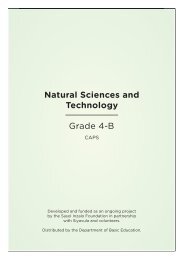Natural Sciences and Technology Grade 6-A - Thunderbolt Kids
Natural Sciences and Technology Grade 6-A - Thunderbolt Kids
Natural Sciences and Technology Grade 6-A - Thunderbolt Kids
Create successful ePaper yourself
Turn your PDF publications into a flip-book with our unique Google optimized e-Paper software.
DID YOU KNOW?<br />
Scientists have a term<br />
for substances like<br />
chlorophyll that have<br />
a colour. They call<br />
them pigments. There<br />
are other pigments in<br />
plants. Can you think<br />
of their colours? There<br />
are pigments in your<br />
body too! Where do<br />
you find them? What<br />
do they do?<br />
DID YOU KNOW?<br />
These holes also allow<br />
other gasses <strong>and</strong><br />
water to enter or<br />
leave the plant. They<br />
do the same job as<br />
your mouth <strong>and</strong> nose<br />
when you breath! The<br />
same job as the pores<br />
in your skin when you<br />
sweat!<br />
1. Chlorophyll: Chlorophyll is agreen substance that plants use to<br />
capture light energy from the sun. Chlorophyll is very important.<br />
Without chlorophyll plants cannot use the sunlight energy to make<br />
food.<br />
2. Sunlight: Sunlight has energy. Plants use this energy to make<br />
sugars from water <strong>and</strong> carbon dioxide.<br />
3. Water: The roots of aplant absorb water <strong>and</strong> nutrients from the<br />
soil. Water is asolvent in all living things. Dissolved substances are<br />
moved around the body to where they are needed. Just like you<br />
plants have veins for this movement. They move minerals from the<br />
roots upwards. They move sugars from the leaves downwards.<br />
Photosynthesis can only happen in awater solution. Water is also<br />
important because it provides support to the plant to keep it<br />
upright. Like you, plants have skeletons. But unlike you many<br />
plants have water skeletons!<br />
4. Carbon dioxide: The plant absorbs or takes in carbon dioxide<br />
from the air through little holes. These holes are found all over the<br />
plant, mostly under the leaves.<br />
5. Soil: The soil provides mineral nutrients <strong>and</strong> water for the plant<br />
that are necessary during photosynthesis. Soil also provides<br />
anchorage to the plant, otherwise the plant cannot st<strong>and</strong> up<br />
straight.<br />
How does photosynthesis occur?<br />
Plants use chlorophyll, sunlight, water <strong>and</strong> carbon dioxide to make<br />
food.<br />
• Chlorophyll captures the sunlight energy.<br />
• This energy splits the water into hydrogen <strong>and</strong> oxygen.<br />
• The oxygen is released into the air.<br />
• The hydrogen is used with the carbon dioxide to make<br />
glucose (sugars).<br />
• The sugars are moved from the leaves to other parts of the<br />
plants where they are stored.<br />
• The water in the plant veins carries the sugars. When the<br />
sugars reach the storage parts they are changed into starch.<br />
• Plants can store the starch in these places:<br />
– leaves (cabbage, spinach, lettuce)<br />
– fruit (apples, banana, peaches)<br />
6 Life <strong>and</strong> Living
















